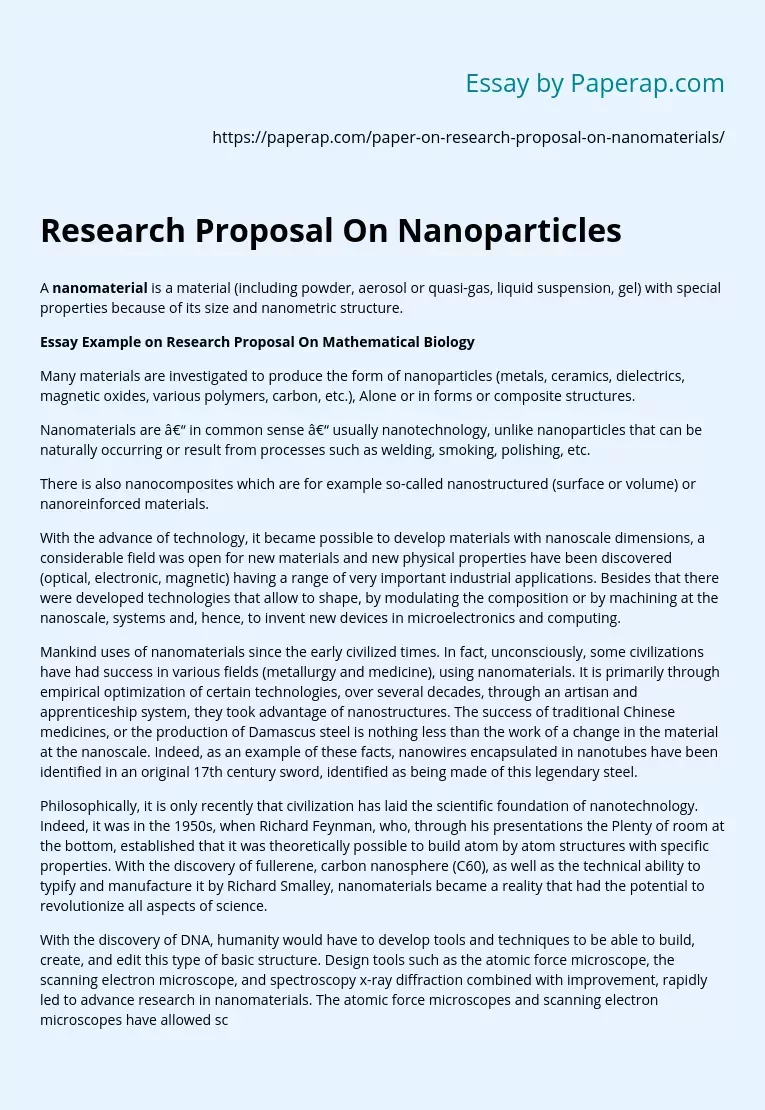Research Proposal On Nanoparticles
A nanomaterial is a material (including powder, aerosol or quasi-gas, liquid suspension, gel) with special properties because of its size and nanometric structure.
Many materials are investigated to produce the form of nanoparticles (metals, ceramics, dielectrics, magnetic oxides, various polymers, carbon, etc.), Alone or in forms or composite structures.
Nanomaterials are – in common sense – usually nanotechnology, unlike nanoparticles that can be naturally occurring or result from processes such as welding, smoking, polishing, etc.
There is also nanocomposites which are for example so-called nanostructured (surface or volume) or nanoreinforced materials.
With the advance of technology, it became possible to develop materials with nanoscale dimensions, a considerable field was open for new materials and new physical properties have been discovered (optical, electronic, magnetic) having a range of very important industrial applications. Besides that there were developed technologies that allow to shape, by modulating the composition or by machining at the nanoscale, systems and, hence, to invent new devices in microelectronics and computing.
Mankind uses of nanomaterials since the early civilized times.
In fact, unconsciously, some civilizations have had success in various fields (metallurgy and medicine), using nanomaterials. It is primarily through empirical optimization of certain technologies, over several decades, through an artisan and apprenticeship system, they took advantage of nanostructures. The success of traditional Chinese medicines, or the production of Damascus steel is nothing less than the work of a change in the material at the nanoscale. Indeed, as an example of these facts, nanowires encapsulated in nanotubes have been identified in an original 17th century sword, identified as being made of this legendary steel.
Philosophically, it is only recently that civilization has laid the scientific foundation of nanotechnology. Indeed, it was in the 1950s, when Richard Feynman, who, through his presentations the Plenty of room at the bottom, established that it was theoretically possible to build atom by atom structures with specific properties. With the discovery of fullerene, carbon nanosphere (C60), as well as the technical ability to typify and manufacture it by Richard Smalley, nanomaterials became a reality that had the potential to revolutionize all aspects of science.
With the discovery of DNA, humanity would have to develop tools and techniques to be able to build, create, and edit this type of basic structure. Design tools such as the atomic force microscope, the scanning electron microscope, and spectroscopy x-ray diffraction combined with improvement, rapidly led to advance research in nanomaterials. The atomic force microscopes and scanning electron microscopes have allowed scientists to “see” a nanologique universe in the same way that the 17th century microbiologists have discovered the inner workings of cells with the development of the optical microscope.
The accelerating research in synthesis methods and increasing availability of nanomaterials of any kind have enabled humanity to what will be reported in the future possibly be the beginning of the Nano age. Today, the multidisciplinary nature of nanotechnology interested researchers in various areas to find solutions to major energy problems, health problems, optimization of existing technologies and promises of this intimate control over nanomaterials are numerous.
Research Proposal On Nanoparticles. (2019, Nov 27). Retrieved from https://paperap.com/paper-on-research-proposal-on-nanomaterials/

